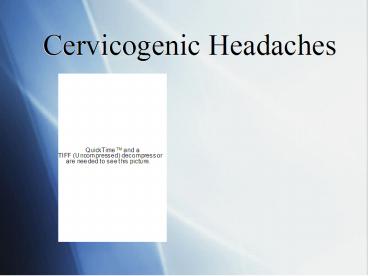Cervicogenic Headaches - PowerPoint PPT Presentation
1 / 28
Title:
Cervicogenic Headaches
Description:
... squeezing the skin, raise a large fold of skin btwn thumb and other fingers. Push thumb toward fingers and release. Pincement. Works Cited. Cesar Fernandez-de ... – PowerPoint PPT presentation
Number of Views:2357
Avg rating:3.0/5.0
Title: Cervicogenic Headaches
1
Cervicogenic Headaches
2
Cervicogenic Headache
- Defined cervicogenic headache is a syndrome
characterized by chronic hemicranial pain that is
referred to the head from either bony structures
or soft tissues of the neck.
3
Causes
- Ergonomics
- Subluxation
- Repetitive motion
- Shoulder
- Neck
4
Repetitive Motion
- Most commonly affects those who overuse a
unilateral or bilateral repetitive motion - Witches
- Butter churners
- Ice cream scoopers
- Receptionists
- Painters
- Hair stylists
5
Our Patient
- Name Dixie
- Occupation Receptionist
- Age 43
- Duties answering phone (no headset) extensive
computer work Brewing and Serving Coffee
6
Symptoms
- Headaches
- Neck pain and stiffness that would start in the
occipital region and travel overhead to the
frontal region - Visualization
7
Findings
- Weak SITS group posterior deltoid Middle
Trapezius - Facilitated SCM Scalenes Upper Trapezius
Levator Scapulae suboccipital muscles - VSC cervical spine
8
Goals
- Short Term
- Restore patient to full ROM
- Decrease Pain
- Mid Rehab
- Return to full ROM with 4-5/5 strength
- Late Rehab
- Return to full function/activity
9
Goals (Cont.)
- Long Term
- Wellness Care
- Proper Mechanics
- Proper Ergonomics
10
Stretching
- Active and passive stretches for
- SCM
- Scalenes
- Pectoralis group
- Superior Trapezius
11
Early Strengthening
- Cervical
- ROM
- Extension 3x10
- Rotation 3x10
- Isometrics
- Chin Tucks with towel resistance
- Rotation with finger resistance
12
Early Strengthening
- Scapula
- Isometrics (with doctor or in a door way)
- External Rotation 2x10
- Internal Rotation 2x10
- Abduction at 20-30 degrees 2x10
- Wall Angels
13
Mid-Stage Strengthening
- Cervical
- Full ROM
- Add resistance with band or doctor resistance
3x10 - Chin tucks
- With a band or ball against a wall standing 3x10
14
Mid-Stage Strengthening
- Scapula
- Ball dribbles on wall
- Up and down 2 x15
- Lateral 2x15
- Wide Rows with band resistance 3x10
- Full ROM
- Add resistance 3x10
15
Late Stage Strengthening
- Cervical
- Chin tucks
- Progress to seated on a ball still using band
3x10 - Patient should by now have full ROM with 5/5
strength if not continue will bands and increase
resistance
16
Late Stage Strengthening
- Scapula
- PNF D1 pattern 3x10
- PNF D2 pattern 3x10
- Deceleration with external rotation 2x10
- teach with doctor performing resistance teach to
use a band at home
17
Ergonomics
- Proper ergonomics must be in place for full
rehabilitation to occur - Desk set up
- Headset
- Cervical pillow
- Slow adaptation
- Will assist in stretching anterior cervical
muscles
18
Basics of Ergonomics
- Best Work Zone
- As far forward as your wrist when you hold your
arm slightly bent - As wide as the shoulders
- Upper level at about heart height
- Lower level at about waist height
19
Work Zones
20
Ergonomic Desk Set Up
21
(No Transcript)
22
Cervical Pillow
- 1st week Patient should lie on cervical pillow
for 5 minutes per night then sleep on regular
pillow - 2nd week Repeat 1st week increasing time to 10
minutes per night - 3rd week Increase time to 15 minutes per night
23
Manipulative Therapy
- Chiropractic Adjustments
- Myofacial Release
- Trigger Points
24
Chiropractic Adjustment
- Find and remove subluxation
25
Myofacial Release
- Increases
- Blood and lymph flow
- Breaks adhesions
- Decreases
- Edema
- Congestion
- Nerve activity
26
Trigger Points
- Upper Trapezium
- Levator Scapulae
- Pectoralis Muscles
27
Massage
- Traction
- Effleurage - stroking movements over large
surface areas of the body - Petrissage - while squeezing the skin, raise a
large fold of skin btwn thumb and other fingers.
Push thumb toward fingers and release. - Pincement
28
Works Cited
- Cesar Fernandez-de-las-Penas. Myofascial Trigger
Points and Their Relationship to Headache
Clinical Parameters in Chronic Tension-Type
Headache. Headache 2006 461264-1272. - Cibulka, Michael. Sternocleidomastoid muscle
imbalance in a patient with recurrent headache.
Manual Therapy. 11 (2006) 78-82 - Ettekoven, H. Efficacy of physiotherapy including
a craniocervical training programme for
tension-type headache a randomized clinical
trial. Cephalalgia. 2006, 26 983-991 - McAtee, Robert. Facilitated Stretching. 2nd.
Champaign Human Kinetics Publishers, 1999. - Mueller, Loretta. Cervicogenic Headache A
Diagnostic and Therapeutic Dilemma. Headache and
Pain. April 2003 pg 29-36.































